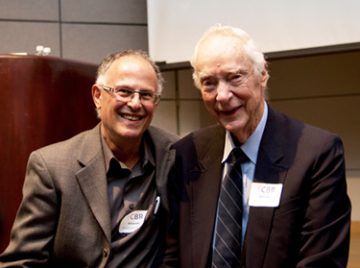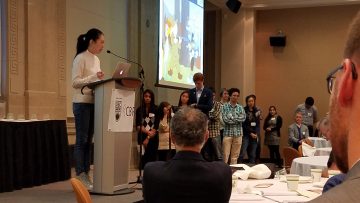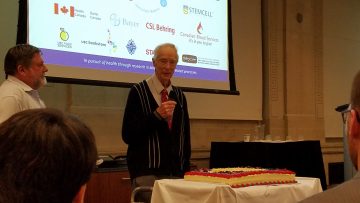By Rolinda Carter, Enoli De Silva, Ulli Felgenhauer, Chanel La, and Bryan Lin
To view videos of this event: https://cbr.ubc.ca/events/earl-w-davie-symposium/
The 10th anniversary of the Earl W. Davie Symposium celebrated the stellar achievements and ongoing positive impact of Dr. Davie’s research on coagulation. The distinguished Dr. Davie, along with his colleagues, spearheaded the discovery of the Waterfall Sequence of Blood Clotting in 1964. His work not only revolutionized our understanding of bleeding and clotting diso

Drs. Ed Conway and Earl W. Davie.
rders, but has also earned him countless scientific accolades, including being named a Legend of Hematology by the American Society of Hematology.
The one-day symposium brings together leading scientists, students and clinicians in the fields of vascular biology, hemostasis-thrombosis, cardiovascular and neurologic disease. What resonated most with the crowd was the attendance of patients living with various forms of clotting and bleeding disorders and who continue to inspire the research being done to treat these diseases. This year, the keynote presentations featured Dr. Nigel Key (UNC) and Dr. John W. Weisel (U Penn) highlighting their ground-breaking contributions to the fields of bleeding and thrombosis.
Dr. Nigel Key kicked off the proceedings with his studies on the effect of DNA on initiating clotting via the contact pathway. He showed that microparticles released by red blood cells can also activate this factor XII-dependent pathway. Following this, Dr. Shannon Jackson (UBC), described the progress and challenges in shifting practices to a personalized approach in the management of haemophilia. She highlighted the need for improved assessments of patients’ quality of life to better balance efficacy and efficiency of their treatments.
Dr. Key:“I am flattered to receive the honor of presenting at this wonderful event. I have huge respect for Earl Davie and the science community that have made this event possible. The talks were terrific, especially the shotgun talks and student abstract talks, as this format that focused more on student participation is not often seen in other science conferences and events.”
Other morning highlights include a talk by Dr. Dominic Chung (Bloodworks Northwest) who shared advances his group has made in identifying contributors of von Willebrand factor (VWF) self-association and hyper adhesive VWF fibers formation. His latest observations suggest that HDL (good cholesterol) and LDL (bad cholesterol) may be playing a role. Dr. Alan Mast of the Blood Centre of Wisconsin then took the stage to give an intriguing talk on tissue factor pathway inhibitor (TFPI), a naturally occurring anticoagulant. He explained that the alpha domain of TFPI and clotting factor V share a well conserved sequence not found in any other protein. He suggested that blocking TFPIα could be used to treat hemophilia A and B, which are currently treated with different therapies. Dr. Kay Htun of VGH then presented a clinical case from a patient with anti-phospholipid antibody syndrome. Her talk brought to light the importance of following up with patients and adjusting treatments to keep patients in a stable state. Her talk strongly resonated with the earlier remarks by Dr. Jackson on the important role of the patient in patient-centred care.
The morning session concluded with 20-second “shotgun” talks from

Students presenting their 20 second “shot-gun” talks.
poster presenters. This year had an exciting line-up of posters showcasing some phenomenal work by the next generation of blood researchers. Three winners of the Poster Competition were chosen by poster judges, with the first place going to Bryan Lin (PhD candidate in Dr. Pryzdial’s lab), second place to Frank Lee (MD/PhD student in Dr. Pryzdial’s lab), and third place to Vivienne Chan (PhD candidate in Dr. Kastrup’s lab).
“When Ed jokingly remarked that the contest was rigged as he announced the top 3 posters, my heart skipped a beat. I am grateful for the support of my fellow lab mates and supervisor in obtaining this award” – commented Bryan Lin, the first place poster winner.
After lunch, Dr. John Weisel captured the audience’s attention with his impressive electron microscope images of blood clots, used in his investigations on platelet aggregation and fibrin polymerization. He described the use of a personalized optical trap system to examine key interactions during the clotting process such as fibrin polymerization. In speaking to Dr. Weisel during the break, mentioned his appreciation for the chance to listen to stories from patients who directly benefit from research in his area of interest. The trapping of red blood cells in venous thrombi was another area discussed at this year’s symposium. In her talk, Dr. Alisa Wolberg (UNC) presented data suggesting that factor-XIII mediated crosslinking of fibrin clots may be at the center of red blood cell retention.
Next, CBR graduate students Steve Hur (Kastrup lab), Frank Lee (Pryzdial lab), and Linda Yang (Scott lab) shared their work on clotting factors XIII, V, and anti-cancer immunotherapy respectively. They were followed by Dr. Alex St. John, a physician from Seattle, showing interesting evidence of von Willebrand factor (VWF) self-association being inhibited by small VWF fragments. In the future, he is looking to explore the implications of this finding in trauma patients.
After the break, Dr. Jacob H. Rand, from Cornell University, explained the difficulties of linking clinical manifestations of anti-phospholipid antibody syndrome with the empirical observations made in laboratory experiments. The final presentation was given by Dr. Jordan Shavit, from the University of Michigan, who shared his fascinating work using zebrafish as models to identify novel genetic modifiers of the coagulation cascade.
As in previous symposia, hearing emotional accounts of the reality of the blood disorders we study from the patients’ perspectives gave us a renewed sense of determination in our efforts to find therapeutic solutions. On the topic of hemophilia care, patient Timothy Ireland provided a heartwarming portrayal of this condition’s significant impact on him and his family. Recounting the progression of medical care he received as a child to what is available now, Timothy expressed his gratitude to Dr. Davie for the influence that his work has had on his quality of life. For instance, clinical studies on the therapeutic maintenance of clotting factors, as described by Dr. Valder Aldurra (U Penn) describe a powerful tool for patients with hemophilia. As a result of these medical breakthroughs, Timothy enjoys weekly doubles tennis sessions, something doctors considered practically inconceivable in his youth. In a beautiful presentation by Daniel, Jacqui, Willow and Georgia Baker, we experienced the difficulties of a family living with anti-phospholipid antibody syndrome. Daniel Baker, his wife and two daughters shared some of their highs and lows in meeting the challenges of some of the devastating symptoms of this disease. In speaking to the Baker family during the break, we heard more about their incredible resilience and support from their medical team.

Dr. Davie giving his remarks.
Closing remarks were made by Dr. Ross MacGillivray, the founding Director of the CBR and the initiator of this annual symposium. Dr. MacGillivray recounted his post-doctoral experience with Dr. Davie, while acknowledging the insights Dr. Davie has had over the years. Dr. Davie himself mentioned that he was deeply honoured to be at the event and hear about exciting research in the field. He thanked the organizers, especially Drs. MacGillivray and Conway, the sponsors, supporters and attendees for a wonderful event. Just before cutting into a 10th anniversary cake, the 90-year old Dr. Davie ended his speech by thanking his friend, Nobel Prize winner Dr. Edmond H. Fisher, aged 96. According to Dr. Davie, Dr. Fisher carries his bags when he is feeling old.
This remarkable symposium would not have been possible without the generous support of our sponsors: Biogen, Novo Nordisk (Platinum donors); Pfizer (Gold); Alexion, Octapharma, CSL-Behring, New England Biolabs, Bayer, StemCell Technologies, Canadian Blood Services (Silver); UBC Food Services, UBC Bookstore, Vancouver Whitecaps, Staples, Mahony & Sons (Bronze).


